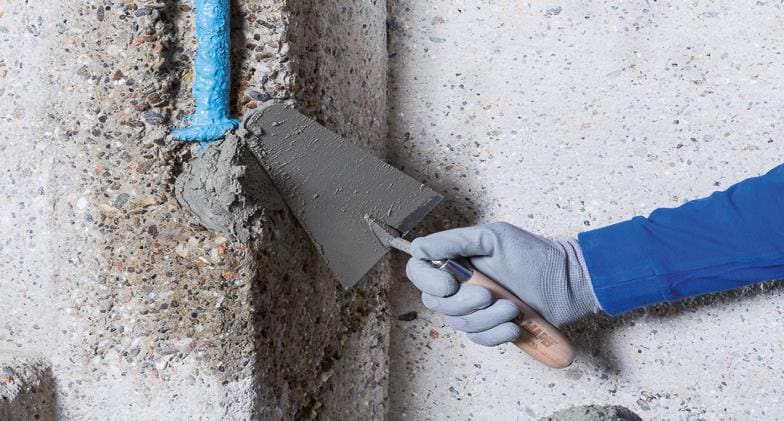The construction industry frequently uses grout to fill gaps between tiles or concrete sections. Non-shrink grout is one such material that is widely used for this purpose. As the name implies, non-shrink grout is a cementitious material that, once hardened, does not shrink. Known for its high-strength applications, this pre-mix product comes with many benefits in standard construction applications. Read on to find out more about non-shrink grout and how they work in the construction industry.
THE COMPOSITION OF NON-SHRINK GROUT
Made with hydraulic cement, which contains ingredients that adapt to cement stone shrinkage, its final volume is either greater than or equal to the mixture poured.
This grout is a pre-mix product with a thin texture and needs only water to be mixed. It can be easily poured into spaces and is often used to fill the gap between two load-bearing structures. Known as a material that sets rapidly, it also develops high durability within a short time.
KEY BENEFITS AND FEATURES OF NON-SHRINK GROUT
1. Shrinkage Compensation
The additives in the grout help counteract the shrinkage caused by water loss during the drying process. As a result, they expand their volume during the plastic or hardening stages.
This quality is critical in formwork repairs, and precision grouting since the mixture will be poured and left to cure in a confined space. The moisture loss is well controlled during the curing as the surface area of the fresh mortar exposed to air is small compared to its volume. This helps the grout to harden and gain strength without losing volume, ensuring it maintains full-bearing contact with the substrate.
2. Flowable Consistency
Non-shrink grouts are designed to be mixed into a fluid consistency before application to ensure proper placement. It should be able to flow easily through congested spaces to fill voids without air entrapment. This is important because it is not always possible to move or compact the material with tools.
3. High Durability
The grout is well known for its ability to gain significant strength in a short period. It ensures long-term durability and a quick return to service. Moreover, the grout mix contains no calcium chloride additives. This lowers the risk of staining and rusting metal contacts or reinforcements. As a result, it enhances the endurance of the material.
4. Multiple Applications
It is common practice to use non-shrink grouts for various concrete repairs as they are considered good-quality mortars with high strength. The following are some of the most popular applications of this material.
- Grout jacking of concrete slabs.
- Grouting under baseplates, columns, and equipment.
- Installing anchor bolts.
- Grouting of ducts and fine fissures.
- Grouting of post-tensioned structural sections.
- Patching holes or cracks in masonry surfaces. These could include honeycombs, tie-bolt holes, accidental damage, break-outs, etc.
- The underpinning of structures and brickwork repairs.
- Pack-filling of gaps and voids.
- Moulded beams, wall panels, columns, structural building members, and curtain walls.
HOW TO APPLY NON-SHRINK GROUT?
There are several steps you should follow when applying the non-shrink grout.
1. Surface Preparation
Make sure the surface is clean, dry, and free of any material that could interfere with the adhesive bonding. It could be anything from dirt and mildew to oil and paint. If the cleaning solutions for these surfaces contain acids, neutralize them before use.
When applying between spaces, remove loose concrete and pay close attention to any material that comes into contact with the grout, including the undersides of bolts, pipes, bedplates, etc.
Some more areas to consider when preparing the surface:
- Provide air relief openings in key positions to avoid air entrapment.
- Examine the metal parts for rust or release agents.
- Wood forms need to be surface-saturated and the seams caulked to prevent leakage.
- All equipment and plates must be levelled precisely and securely bolted to shims.
After cleaning, wet the concrete surfaces thoroughly with clean water. However, before applying the grout, ensure there is no puddled water in the concrete.
2. Mixing
Non-shrink grout can be made by simply adding water to the mixture. The ingredient ratio, mixing time, and mixer type can all vary depending on the scale of the application and the flowable consistency required.
3. Placing (Application)
The grout should be placed according to standard procedures and based on the purpose of the application. The tools and machinery used will be determined by the process.
4. Curing
Curing must begin immediately after application and is necessary for the grout to be strong. Various materials, including curing compounds, can be used to accomplish this, and the duration will vary depending on the product used.
Grouts like these are used best in places where power and stability are essential, as they can withstand heavy loads and provide structures with the durability necessary to stand the test of time.
NON-SHRINK GROUT – WHERE TO BUY IN SINGAPORE?
If you are looking for a non-shrink grout that can provide the perfect strength and stability to your structure in Singapore, do not hesitate to reach out to Eastern Win. They are a leading construction chemicals and products distributor with over 40 years of experience in the industry. For more information, visit https://www.easternwin.com/.

